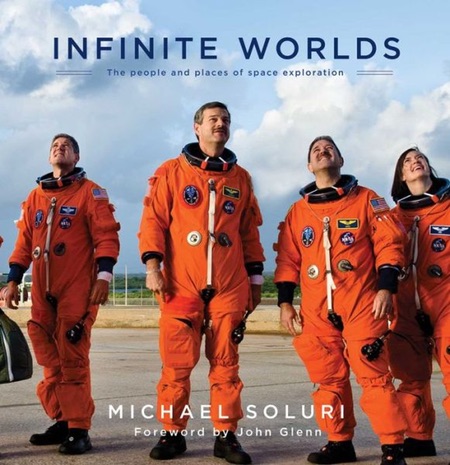Review: Infinite Worldsby Jeff Foust
|
| While ostensibly about one particular shuttle mission, Infinite Worlds is in many respects a look back on the Space Shuttle program in general, and the people who worked on it. |
That past looks particularly poignant when reading Infinite Worlds, the new large-format book by photographer Michael Soluri. The title makes the book sound like one about astrophotography, and there are in fact images of planets, nebulae, and galaxies in the book. However, the book is in fact about the Space Shuttle program and one particular mission: STS-125, the fifth and final servicing mission to the Hubble Space Telescope in 2009.
Soluri got behind-the-scenes access to the STS-125 crew as they trained for the mission, and as technicians prepared the shuttle for that flight. He skillfully catalogs those preparations with a combination of posed portraits and candid shots of the preparations by the astronauts, shuttle technicians, and engineers at NASA Goddard developing the tools and procedures for the Hubble repairs. Those photos are augmented with NASA’s own images from the mission (since Soluri, of course, couldn’t come along) and Hubble’s own handiwork.
The book, though, is not just a collection of Soluri’s photos. He lets the various people involved with STS-125 tell their stories in brief essays. These include some members of the crew, flight controllers, engineers involved in the Hubble repair effort, and shuttle technicians. They talk about how they involved in spaceflight, and also offer some vignettes and insights about this particular mission. Astronaut Mike Massimino, for example, notes that for a typical spacewalk on the International Space Station, astronauts spend seven hours in the Neutral Buoyancy Laboratory—the giant pool at the Johnson Space Center where weightlessness can be at least partially simulated—for every hour of the planned spacewalk. For STS-125, the ratio was 15-to-1 given the complexity of the work. “Our colleagues flying to the ISS told us we needed that much training because we were slow learners,” he quips.
While ostensibly about one particular shuttle mission, Infinite Worlds is in many respects a look back on the Space Shuttle program in general, and the people who worked on it, some of who profiled in the book either moved on of the own volition (like Massimino, who left the astronaut corps and now teaches at Columbia University) or were laid off as the program wound down. STS-125 took place just five and a half years ago, but it now seems firmly a part of another era of spaceflight. A part of that era is expertly recorded, both in words and photos, in this book.
